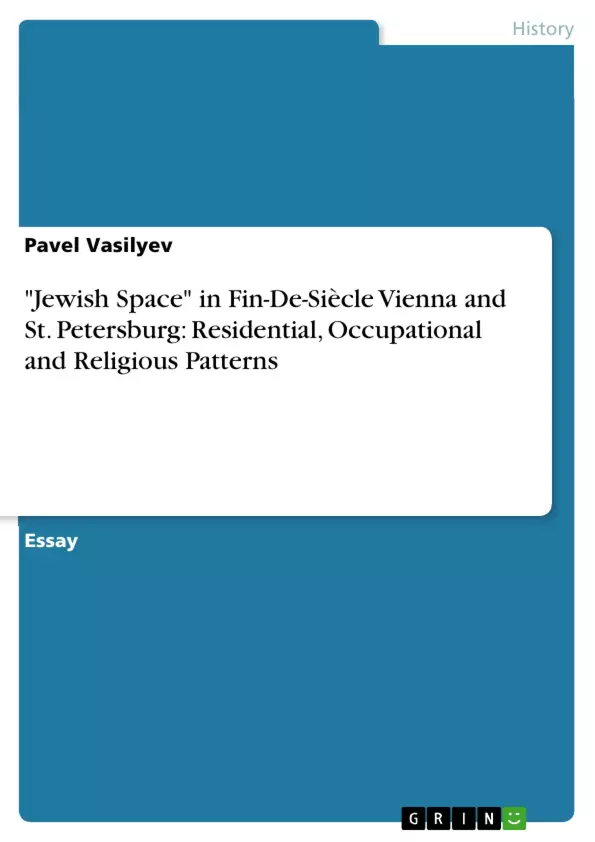At first glance, the historical Jews do not seem to have been a group that was determining the architectural, visual and spatial outlook of cities – in Europe or overseas alike. In fact, as Rudolf Klein put it, “the Jews were seldom in a position – save in ancient and modern Israel – to impose architecture on others”; partially because they “moved so many times in history that they lacked the preconditions for a continuous architectural evolution”. Moreover, architecture has always been considered a Jewish 'specialty' much less then, say, literature, medicine or business. However, I will show that a closer look at the connections between the Jews and the urban space is an important and promising enterprise that tells us a lot about the Jews, the city – and also about Gentiles.
The focus of this paper is on the fin-de-siècle period (late 19th – early 20th centuries) and on the two capital cities of Vienna and St. Petersburg – and for some reasons. Both cities were capitals of the empires (Austria-Hungary and the Russian Empire, respectively), that were powerful enough to be a major military and financial competitors, but still technologically and economically backward. The transition to modernity in both capitals was late and problematic, and the Jewish communities have faced a long and persistent anti-Semitism. In both contexts, however, the Jews were especially successful and over-represented in the most modern professions – and also more visible in the rapidly changing modern urban space. Thus, this paper also compliments to the perspective that analyzes “Jewish space” in fin-de-siècle capitals – and brings a comparative element into the picture.
Accordingly, in this paper I will look at the Jewish experiences in turn-of-the-century Vienna and St. Petersburg to compare the visions, images and representations of the “Jewish space” in the two imperial capitals that were struggling through modernity. I am particularly interested in residential, occupational and religious aspects of the “Jewish space” as these were the factors that determined the everyday life cycle of particular Jews. Additionally, I want to trace the potential influence that the Jewish patterns of space organization may have exercised upon Gentile ones around turn of the century.
Inhaltsverzeichnis (Table of Contents)
- Residential aspect: Jewish homes
- The issue of dispersion was actually a major characteristic feature of the Viennese Jewry, especially since the early 20th century.
- The other Viennese districts with sizable Jewish communities were of very diverse nature as well.
- In Russian context, the importance of the Pale experience was still an important factor, which led to the situation when “the territorial dimension was reenacted daily on a smaller scale”.
- The reality, however, was that the Jews (in absence of any major territorial restrictions within St. Petersburg) actually settled in all twelve of capital's districts.
- Perhaps even more important that the actual location, was the inner structure of these Jewish neighborhoods.
- Occupational aspect: The places to work
- In the Habsburg capital, the Jewish workplaces tended to concentrate in two main areas: Inner City and Leopoldstadt.
- Religious aspect: Synagogues and prayers
- As we have already seen in the residential context, the Jewish communities of Vienna and St. Petersburg were not homogenous at all – neither by their class, nor by their religious beliefs.
Zielsetzung und Themenschwerpunkte (Objectives and Key Themes)
This paper examines the relationship between Jewish communities and urban space in Vienna and St. Petersburg during the fin-de-siècle period. It explores how Jewish residential, occupational, and religious practices shaped their “Jewish space” within these two imperial capitals, and how these patterns potentially influenced the spatial organization of Gentile communities.
- Residential patterns of Jewish communities in Vienna and St. Petersburg
- Occupational characteristics and distribution of Jewish workplaces in both cities
- Religious practices and the role of synagogues in shaping Jewish space
- The impact of Jewish spatial patterns on Gentile communities
- The influence of social class, ethnicity, and language on Jewish residential choices
Zusammenfassung der Kapitel (Chapter Summaries)
The paper begins by highlighting the paradoxical nature of Jewish spatial influence, arguing that while they may not have directly determined urban architecture, their presence and activities shaped distinct “Jewish spaces” within Vienna and St. Petersburg. The paper then delves into the complexities of Jewish residential patterns, examining the diverse locations and social dynamics within these communities. It contrasts the dispersion of Viennese Jews with the more concentrated settlements in St. Petersburg, exploring the role of class, ethnicity, and language in shaping residential choices. The chapter concludes by examining the occupational characteristics of Jewish communities, focusing on the concentration of small businesses in Vienna's Inner City and Leopoldstadt.
Schlüsselwörter (Keywords)
The primary keywords and focus topics of this paper include "Jewish space," fin-de-siècle Vienna and St. Petersburg, residential patterns, occupational characteristics, religious practices, social class, ethnicity, language, and the impact of Jewish spatial patterns on Gentile communities. The paper also explores concepts such as the Pale of Settlement, ghettoization, assimilation, and the influence of modernity on urban space.
- Arbeit zitieren
- Pavel Vasilyev (Autor:in), 2010, "Jewish Space" in Fin-De-Siècle Vienna and St. Petersburg: Residential, Occupational and Religious Patterns, München, GRIN Verlag, https://www.grin.com/document/163780



